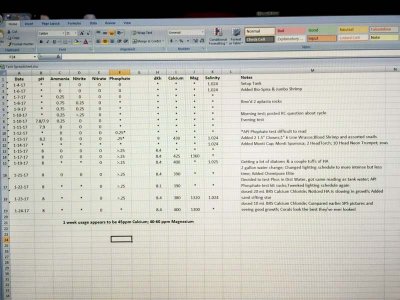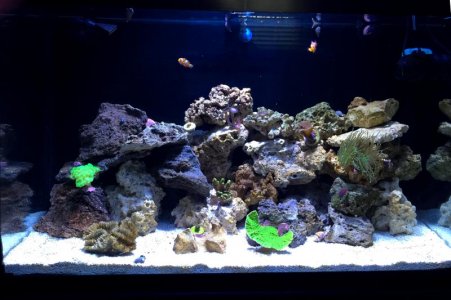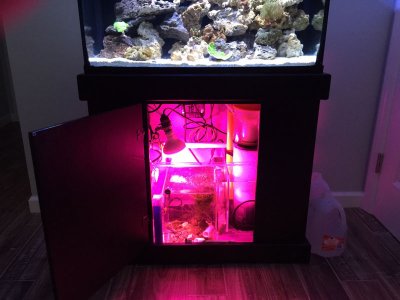ReeferNtraining
New member
For what it's worth, I just wanted to document my journey so far in order to let other newbs like myself get some easy to understand information. Please don't blast me for chemistry issues that I may get wrong. Again, I am just trying to help new reefers and share the knowledge I have gained, however slightly erroneous I may be. It could save someone from hours of scouring RC, like I have, trying to get things right. I just feel like I should give back to RC. This is the first time I have attached pictures, so please bare with me.
The first thing I will say to a new reefer is TEST, document, TEST, document. And when you think you've done enough....TEST AGAIN. I was into reefing for a couple years about 8 years ago. I bought a house and didn't have time to care for the tank so I sold/gave away everything. I am now in a position to do this again and I am trying to do things right this time. My tank has been up since 1-4-17. Now, that is misleading because when I originally set the tank up in early December, it leaked and I had to "preserve" everything that I had already cured and put in the tank. The sand, the live rock and the miracle mud. So all of that was again "curing" while I waited to get the tank resealed and setup again. As you will read later, I think that helped mature my setup a lot quicker than normal. Here is my spreadsheet of my documentation throughout this process.

The first thing I thought about and researched was my sand. In my old tank, I fought nitrates (NO3) constantly and had a lot of algae problems. I think alot of that had to do with my deep sand bed in my display. So in this setup, I chose to only use 1.5"-2" sand and utilize burrowing critters to keep the sand stirred up in hopes that I do not have nutrient buildup in the substrate. I also buy distilled water due to my small tank size. It is more cost effective and reliable. I use a TDS meter to check each gallon before mixing salt or adding top off.
The next thing I would like to say is I believe the combination of Miracle Mud and Bio-Spira helped me to quickly establish the good bacteria that process waste. Patience in the beginning is key to success. I started this cycle by throwing a jumbo shrimp, from the local deli, into the sump. As you can see from the spreadsheet, my cycle was quick and I was able to add livestock and not see any change in my numbers. I tested often, even with nothing in the tank, before adding my 3 small fish. Again, I researched to be sure that the clowns, wrasse, blood shrimp and CUC would all get along without killing each other. A good example in my old setup was the fact that I had about 10 blue leg hermit crabs and couldn't figure out why my snails kept disappearing. Same issue with a hawkfish and shrimp. Incompatible and they just become food. Trying to avoid that this time!
I know that everyone says that you can't add SPS to an immature tank. However, there was a frag swap the same weekend as when I added my fish and CUC (clean up crew). I could not pass up the tremendous deals on the coral. I had wanted a hardy SPS to try and found that Montipora is a good beginner SPS. I did alot of research before going to the frag swap. I figured that if the SPS started failing, I could just give them to my LFS. Well, that is far from the case. All the fish and corals that I purchased are doing incredibly well after 10 days. Again, you can see some of the details in my notes on the spreadsheet. I feel that if you test and get a good understanding of what your tank is doing, you can be successful.
So that brings me to the alkalinity, calcium, magnesium triad. After the corals got acclimated and I seen polyp extension, I monitored these 3 components and researched alot on reef central. What I have learned is the corals will utilize these three components while growing. I read alot about kalkwasser and dosing pumps and really got a headache. I happened to find one thread by Bertoni where he broke it down pretty simply and said that you can raise CALCIUM ONLY by using Calcium Chloride. IME, I am not seeing the alkalinity decrease. So far, only calcium is being consumed at roughly 45ppm/week and the magnesium about 40-60. I purchased the Bulk Reef Supply Calcium Chloride and mixed as instructed. I decided on the BRS product because of the price and the fact that you can mix it into a 1 gallon jug. Drs Foster Smith had a mix that was 1 gram per 10 gallons of water. That seemed far too powerful for me. Although it was a good price. With my small water volume, it was simply overkill. I then went to the BRS website and used the calculator that instructed me to use 4.3 teaspoons to raise the Calcium from 380 to 425. I converted that to mL and added 20 mL of the mix yesterday. Today, all my parameters are stable and the calcium has come up to 400. So what I have learned is to test to see what your tank is using and then do small doses to correct the parameters. So, to put it simply, if your tank is only using calcium you dose Calcium Chloride. If your tank is using calcium AND alkalinity, you will dose Calcium Hydroxide. Alot of threads on RC seem to go way too far into the chemistry and often lose me. If another one of my parameters seem to get out of line, I will address it when it develops. I really don't want to put anything in my tank that is not needed. It's a learning process for me and I am extremely happy to see my green Montipora Cap and my Montipora Spumosa doing so well in such a new tank. So, it is possible!!
1 other note.... the API Phosphate test kit is absolutely worthless. I was using it and it appeared that I had some phosphate because the water was grey and not yellow. So, for the first 10 tests or so, I just assumed that I was around .25 or less on the phosphate. Well, then I decided to test my distilled water and put that test tube next to my tank water test tube. Both look more than 0 but less than .25. So, I would stay away from that kit and probably get the Hannah Checker. That is going to be my next purchase.
I hope this helps someone that is new to LPS/SPS and looking for some easy to understand language.
Here is a Pic of my tank and sump....


The first thing I will say to a new reefer is TEST, document, TEST, document. And when you think you've done enough....TEST AGAIN. I was into reefing for a couple years about 8 years ago. I bought a house and didn't have time to care for the tank so I sold/gave away everything. I am now in a position to do this again and I am trying to do things right this time. My tank has been up since 1-4-17. Now, that is misleading because when I originally set the tank up in early December, it leaked and I had to "preserve" everything that I had already cured and put in the tank. The sand, the live rock and the miracle mud. So all of that was again "curing" while I waited to get the tank resealed and setup again. As you will read later, I think that helped mature my setup a lot quicker than normal. Here is my spreadsheet of my documentation throughout this process.
The first thing I thought about and researched was my sand. In my old tank, I fought nitrates (NO3) constantly and had a lot of algae problems. I think alot of that had to do with my deep sand bed in my display. So in this setup, I chose to only use 1.5"-2" sand and utilize burrowing critters to keep the sand stirred up in hopes that I do not have nutrient buildup in the substrate. I also buy distilled water due to my small tank size. It is more cost effective and reliable. I use a TDS meter to check each gallon before mixing salt or adding top off.
The next thing I would like to say is I believe the combination of Miracle Mud and Bio-Spira helped me to quickly establish the good bacteria that process waste. Patience in the beginning is key to success. I started this cycle by throwing a jumbo shrimp, from the local deli, into the sump. As you can see from the spreadsheet, my cycle was quick and I was able to add livestock and not see any change in my numbers. I tested often, even with nothing in the tank, before adding my 3 small fish. Again, I researched to be sure that the clowns, wrasse, blood shrimp and CUC would all get along without killing each other. A good example in my old setup was the fact that I had about 10 blue leg hermit crabs and couldn't figure out why my snails kept disappearing. Same issue with a hawkfish and shrimp. Incompatible and they just become food. Trying to avoid that this time!
I know that everyone says that you can't add SPS to an immature tank. However, there was a frag swap the same weekend as when I added my fish and CUC (clean up crew). I could not pass up the tremendous deals on the coral. I had wanted a hardy SPS to try and found that Montipora is a good beginner SPS. I did alot of research before going to the frag swap. I figured that if the SPS started failing, I could just give them to my LFS. Well, that is far from the case. All the fish and corals that I purchased are doing incredibly well after 10 days. Again, you can see some of the details in my notes on the spreadsheet. I feel that if you test and get a good understanding of what your tank is doing, you can be successful.
So that brings me to the alkalinity, calcium, magnesium triad. After the corals got acclimated and I seen polyp extension, I monitored these 3 components and researched alot on reef central. What I have learned is the corals will utilize these three components while growing. I read alot about kalkwasser and dosing pumps and really got a headache. I happened to find one thread by Bertoni where he broke it down pretty simply and said that you can raise CALCIUM ONLY by using Calcium Chloride. IME, I am not seeing the alkalinity decrease. So far, only calcium is being consumed at roughly 45ppm/week and the magnesium about 40-60. I purchased the Bulk Reef Supply Calcium Chloride and mixed as instructed. I decided on the BRS product because of the price and the fact that you can mix it into a 1 gallon jug. Drs Foster Smith had a mix that was 1 gram per 10 gallons of water. That seemed far too powerful for me. Although it was a good price. With my small water volume, it was simply overkill. I then went to the BRS website and used the calculator that instructed me to use 4.3 teaspoons to raise the Calcium from 380 to 425. I converted that to mL and added 20 mL of the mix yesterday. Today, all my parameters are stable and the calcium has come up to 400. So what I have learned is to test to see what your tank is using and then do small doses to correct the parameters. So, to put it simply, if your tank is only using calcium you dose Calcium Chloride. If your tank is using calcium AND alkalinity, you will dose Calcium Hydroxide. Alot of threads on RC seem to go way too far into the chemistry and often lose me. If another one of my parameters seem to get out of line, I will address it when it develops. I really don't want to put anything in my tank that is not needed. It's a learning process for me and I am extremely happy to see my green Montipora Cap and my Montipora Spumosa doing so well in such a new tank. So, it is possible!!
1 other note.... the API Phosphate test kit is absolutely worthless. I was using it and it appeared that I had some phosphate because the water was grey and not yellow. So, for the first 10 tests or so, I just assumed that I was around .25 or less on the phosphate. Well, then I decided to test my distilled water and put that test tube next to my tank water test tube. Both look more than 0 but less than .25. So, I would stay away from that kit and probably get the Hannah Checker. That is going to be my next purchase.
I hope this helps someone that is new to LPS/SPS and looking for some easy to understand language.
Here is a Pic of my tank and sump....



